Minotaur V Launch Vehicle
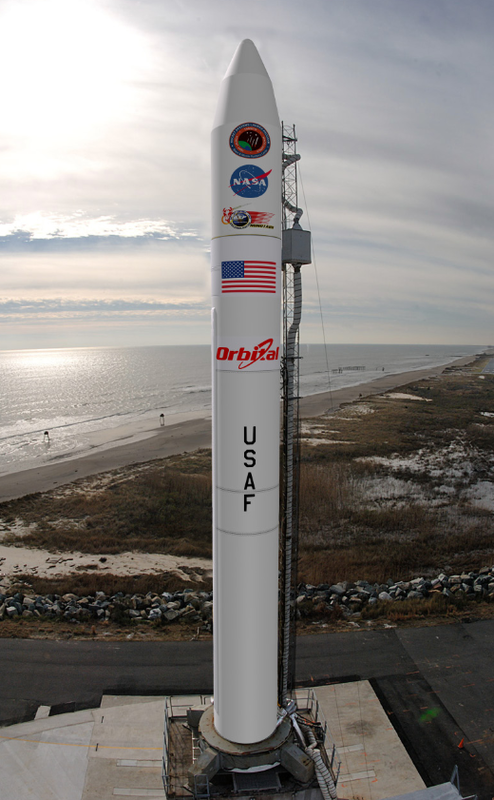
The Minotaur V is an expendable launch system developed and operated by Orbital Sciences Corporation and the US Air Force.
The launcher is based on the all-solid Minotaur IV launch vehicle which itself is based on the Peacekeeper Intercontinental Ballistic Missile.
Peacekeeper was a land-based ICBM that began development in 1972. At the time, silo-based Minuteman ICBMs were being deployed by the US.
The development of the R-36M missile by the Soviets gave the Soviet Union the theoretical the ability to destroy the US Minuteman ICBM facilities before retaliation would have been possible. This prompted the development of the Peacekeeper launcher that could also deliver warheads to orbit via a Post Boost Vehicle and Deployment Module to independently target the individual warheads.
The first test launch of the Peacekeeper took place in 1983 from Vandenberg Air Force Base in California and the system was deployed in 1986. In 2003, the retirement process of the Peacekeeper was started and by September 2005, the last Peacekeeper was removed from alert status.
Peacekeeper warheads are being deployed on Minuteman III missiles that is the only land-based ICBM currently in use by the United States. The Peacekeeper rockets themselves are being converted to orbital launch vehicles by Orbital Sciences. The rockets are converted by fitting them with a fourth stage (& optional 5th & 6th stages) and by installing Orbital’s enhanced avionics systems and advanced composite structures to facilitate its payloads.
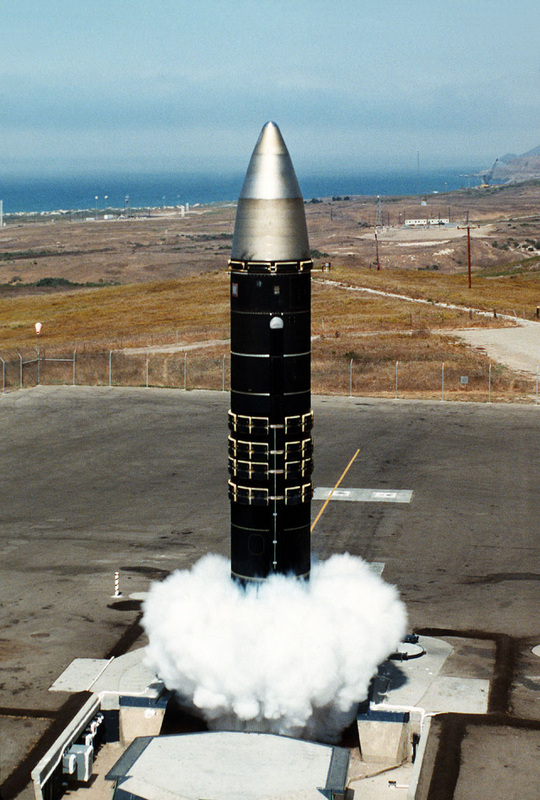
Combining the robust heritage components flown on the Peacekeeper and advanced avionics and support systems create a low-cost launch vehicle for use to support government-financed launches.
To make the launch systems more flexible, Orbital Sciences developed different versions of the basic four-stage Minotaur IV. In its Minotaur IV+ configuration, the vehicle uses a the more powerful Star-48V upper stage instead of the Orion-38. Flying entirely without a fourth stage, Minotaur IV Lite can be used for sub-orbital flights.
In the Minotaur V configuration, a Star 37 rocket stage is added to the IV+ four-stage stack for launches to trans-lunar trajectories and Geosynchronous Transfer Orbit. A six-stage Minotaur VI version has also been conceptualized.
Minuteman launch vehicles are operated from Space Launch Complex 8 at Vandenberg Air Force Base, Launch Pad 1 at Kodiak Launch Complex (Alaska) and Pad 0B at the Mid-Atlantic Regional Spaceport (MARS), Virginia.
Minotaur IV has launched five times starting in April 2010. The Minotaur V version has not flown and its first launch is planned to be to deliver NASA’s LADEE spacecraft to a trans-lunar trajectory.
.
Minotaur IV+ Evolution to V
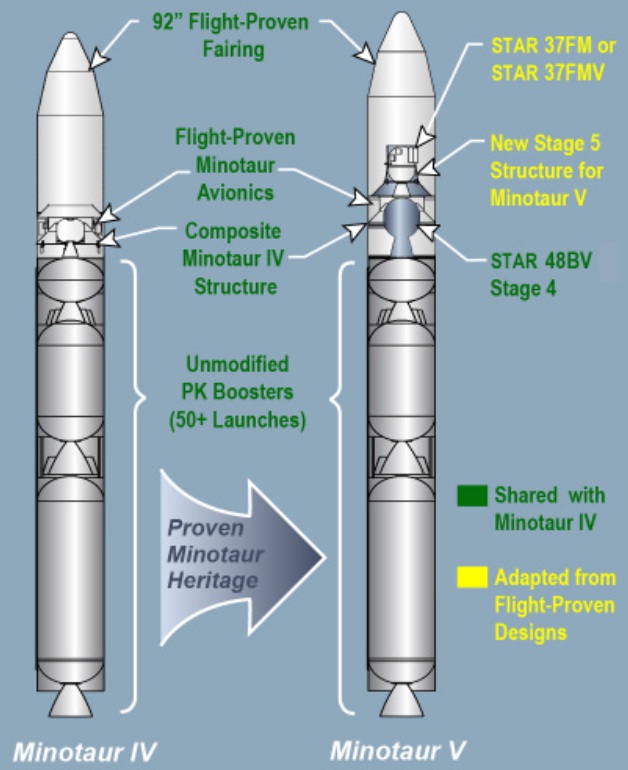
| Type | Minotaur V |
| Launch Site | Vandenberg, Kodiak, MARS |
| Height | ~24.5m |
| Diameter | 2.34m |
| Launch Mass | ~89,000kg |
| Stages | 5 |
| Stage 1 | SR-118 |
| Stage 2 | SR-119 |
| Stage 3 | SR-120 |
| Stage 4 | Star 48 BV |
| Stage 5 | Star 37 (FM or FMV) |
| Mass to GTO | 532kg |
| Mass to MTO | 650kg (CCAFS), 603kg (WFF) |
| Mass to TLI | 342kg |
Minotaur V Specifications
The Minotaur V launch vehicle stands nearly 24.5 meters tall with a diameter of 2.34 meters and a liftoff mass of about 89,000 Kilograms.
It uses the three stages of the Peacekeeper rocket designated SR-118, SR-119 and SR-120. These stages are provided by the US government and are used without any major modifications. Minotaur V uses two solid-fueled upper stages manufactured by Alliant Techsystems making it an all-solid launch vehicle.
The fourth stage is an ATK Star 48 BV rocket motor and the fifth stage is the smaller Star-37 that can be flown in two different configurations.
Minotaur V can deliver small payloads to a variety of trajectories including Medium Earth Transfer Orbit, Geosynchronous Transfer Orbit and Trans-Lunar Trajectories.
First & Second Stage.
| First Stage | |
| Type | SR-118 (TU-903) |
| Diameter | 2.34m |
| Length | 8.4m |
| Propellant | Solid – HTPB |
| Launch Mass | 49,000kg |
| Empty Mass | 3,600kg |
| Propellant Mass | 45,400kg |
| Guidance | via Booster Control Module |
| Propulsion | TU-903 |
| Thrust | 2,224kN |
| Burn Time | 56.5sec |
| Specific Impulse | 229sec (SL), 284sec (Vac) |
| Control | Hydraulic Thrust Vector Control |
| Second Stage | |
| Type | SR-119 |
| Diameter | 2.34m |
| Length | 7.9m |
| Propellant | Solid – HTPB |
| Launch Mass | 27,700kg |
| Empty Mass | 3,200kg |
| Propellant Mass | 24,500kg |
| Engine | With extendable Exit Cone |
| Guidance | via Booster Control Module |
| Thrust | 1,223kN |
| Burn Time | 61sec |
| Specific Impulse | 308sec (Vac) |
| Control | Hydraulic Thrust Vector Control |
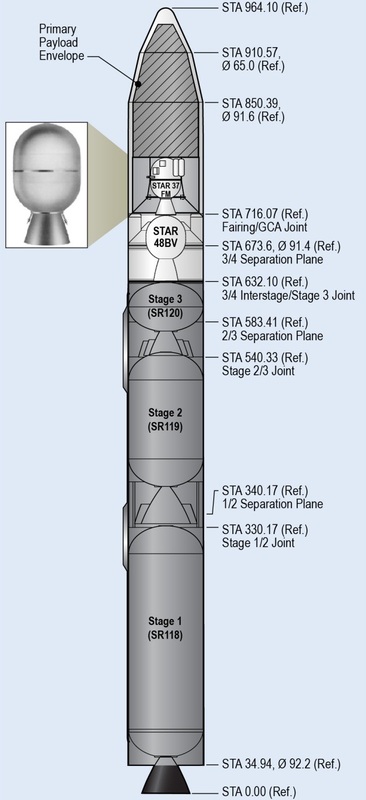
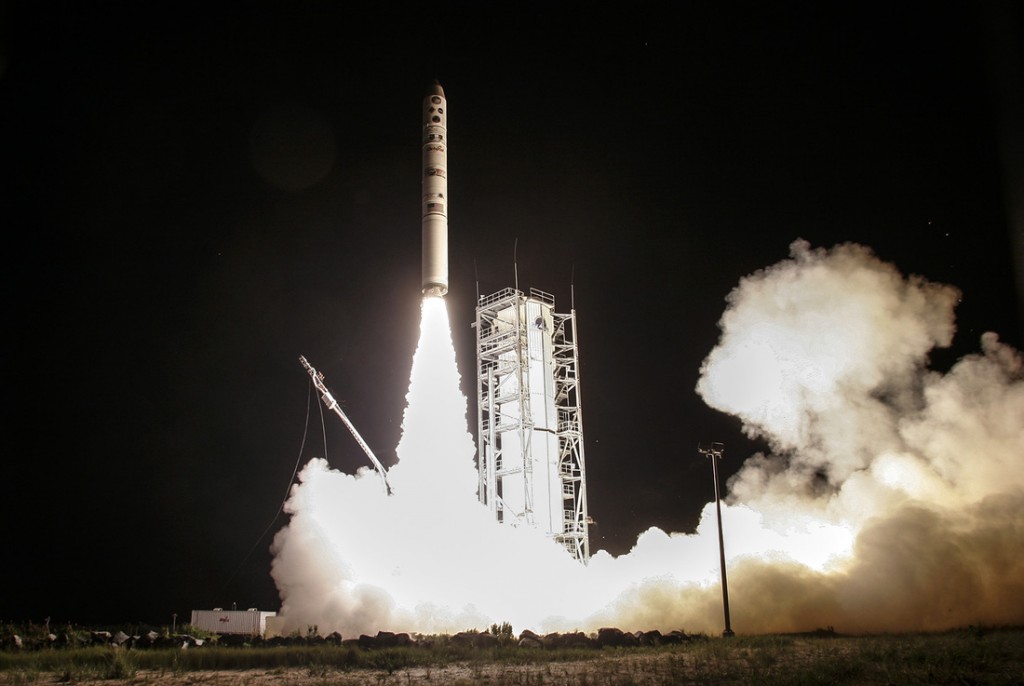
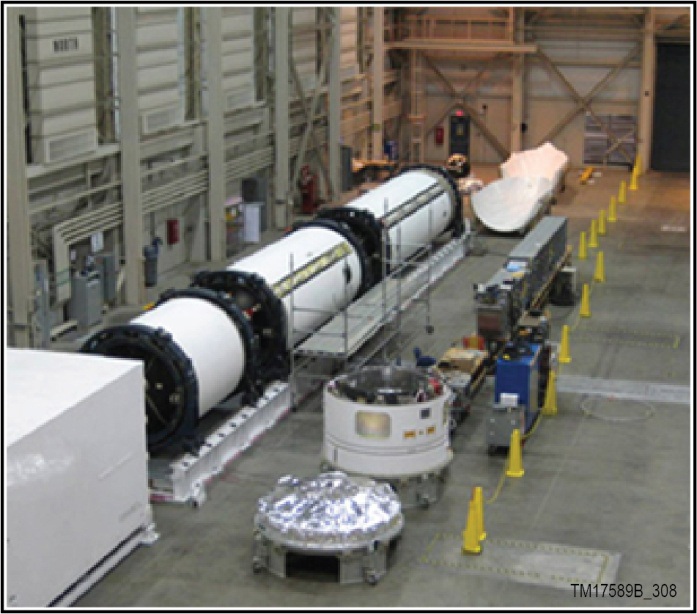
The first stage of the Minotaur V rocket is the first stage of the Peacekeeper that is flown without major modifications. SR-118 was manufactured by Thiokol and is also known as TU-903 and uses HTPB (Hydroxyl-terminated polybutadiene) based propellants. The first stage is loaded with 45,400kg of propellant that is consumed during the 56.5-second burn of the stage to provide 2,224 Kilonewtons of thrust (226,780 Kilograms).
Control during first stage flight is provided by a hydraulic Thrust Vector Control System steered with actuator commands provided by the Booster Control Module that links the flight computer to the TVC system.
The second Stage of the Minotaur launcher was manufactured by Aerojet and also uses HTPB-based propellant. It is 2.34 by 7.9 meters in size with a launch mass of 27,700 Kilograms. It closely resembles the design of the first stage and also uses a hydraulic Thrust Vector Control System that provides attitude control during the 61-second burn of the second stage. It provides a thrust of 1,223 Kilonewtons (124,710 Kilograms).
Third Stage
| Type | SR-120 |
| Diameter | 2.34m |
| Length | 2.44m |
| Propellant | Solid – NEPE |
| Launch Mass | 7,720kg |
| Empty Mass | 650kg |
| Propellant Mass | 7,080kg |
| Engine | With extendable Exit Cone |
| Guidance | via Booster Control Module |
| Thrust | 289kN |
| Burn Time | 72sec |
| Specific Impulse | 300sec (Vac) |
| Control | Hydraulic Thrust Vector Control |
The SR-120 served as third stage of the Peacekeeper and is also used as the Minotaur third stage.
SR-120 was manufactured by Hercules and uses NEPE propellant containing HMX with greater energy than ammonium perchlorate that is used in most composite HTPB propellants. Propellants containing HMX are not used on commercial launchers because of its explosive hazards, but as a converted ballistic missile, Minotaur uses the unmodified SR-120 with NEPE propellant.
SR-120 is 2.34 meters in diameter, 2.44 meters long and has a total mass of 7,700 Kilograms. It burns for 72 seconds and provides 289kN of thrust (29,470 Kilograms). It also uses a hydraulic thrust vector control system to provide attitude control during its burn.
After the third stage burn, the Minotaur usually performs a coast phase to reach higher altitudes so that the following upper stage burns can serve as circularization maneuvers and raise the perigee of the sub-orbital trajectory to achieve orbit.
Star 48BV
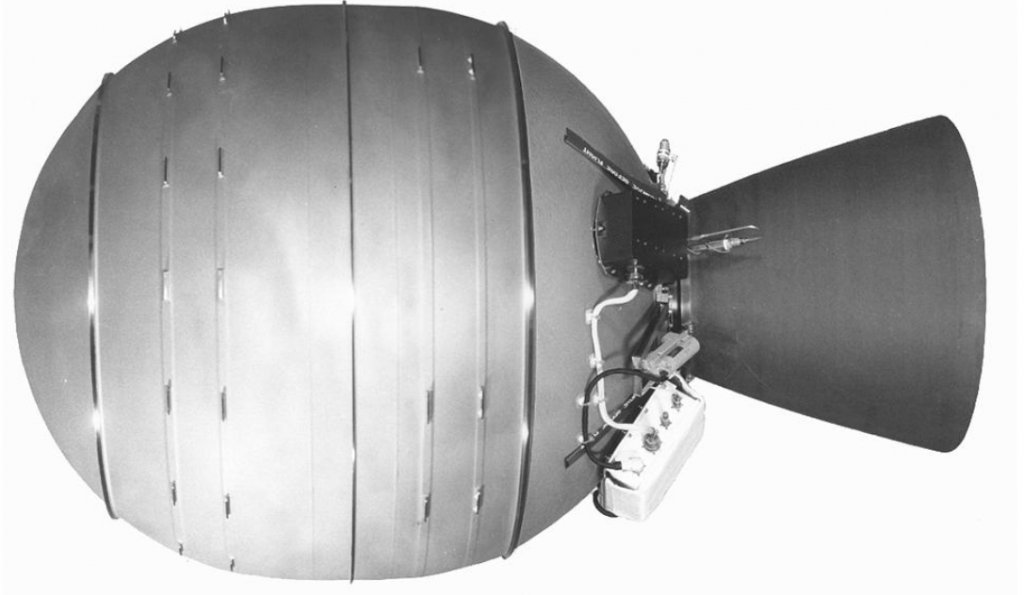
| Type | Star 48BV |
| Launch Mass | 2,164.5kg |
| Diameter | 1.24m |
| Length | 2.08m |
| Propellant | TP-H-3340 |
| Propellant Mass | 2,010.0kg |
| Casing Mass | 58.3kg |
| Case Material | Titanium |
| Nozzle Mass | 52.6kg |
| Avg Thrust | 68.6kN |
| Max Thrust | 77.8kN |
| Isp | 288s |
| Throat Diameter | 0.1011m |
| Nozzle Diameter | 0.7475m |
| Chamber Pressure | 39.9bar (Avg) – 42.6bar (Max) |
| Expansion Ratio | 54.8 |
| Burn Time | 84.1s |
| Ignition Delay | 0.100s |
| Attitude Control | TVC +/-4° |
| Roll ACS |
The fourth Stage of the Minotaur V launcher is the Star-48 Solid Rocket Motor built by Alliant Techsystems. The ATK Star 48BV is a solid-propellant upper stage that uses the flight proven Star 48B and adds Thrust Vector Capability (V).
Star 48 was introduced in 1982 and has been used on a variety of spacecraft. Star 48B was spin stabilized and had smaller a performance than the TVC capable version.
The upper stage features a 1.24-meter diameter titanium casing holding a total of 2,010 Kilograms of solid propellant.
It is 2.08 meters in length and has a launch mass of 2,165 Kilograms. It operates at an average thrust of 68.6 Kilonewtons (6,995kg) with peak thrust reaching 77.8kN (7,930kg).
Star-48BV features the longer of two available nozzles for the conventional Star 48. The upper stage features an electromechanically actuated flexseal nozzle Thrust Vector Control System with a maximum nozzle gimbal of four degrees. Star-48 burns for 84 seconds.
Star 48BV is the final stage of the Minotaur IV+ launcher and is capable of relatively precise insertions. On the Minotaur V, an additional fifth stage is installed to improve performance for highly elliptical and trans-lunar trajectories.
Star 37 – Type FM or FMV
| Type | Star 37FM |
| Launch Mass | 1,148kg |
| Diameter | 0.93m |
| Length | 1.69m |
| Propellant | TP-H-3340 |
| Propellant Mass | 1,065.9kg |
| Casing Mass | 32.25kg |
| Case Material | Titanium |
| Nozzle Mass | 34.02kg |
| Avg Thrust | 47.3kN |
| Max Thrust | 54.8kN |
| Isp | 290s |
| Throat Diameter | 0.0894m |
| Nozzle Diameter | 0.6215m |
| Chamber Pressure | 37.2bar (Avg) – 44.3bar (Max) |
| Expansion Ratio | 48.0 |
| Burn Time | 62.7s |
| Ignition Delay | 0.130s |
| Stabilization | Spin Stabilized – 60RPM |
| Type | Star 37FMV |
| Launch Mass | 1,170kg |
| Diameter | 0.93m |
| Length | 1.92m |
| Propellant | TP-H-3340 |
| Propellant Mass | 1,063.8kg |
| Casing Mass | 32.25kg |
| Case Material | Titanium |
| Nozzle Mass | 44.91kg |
| Avg Thrust | 48.84kN |
| Max Thrust | 55.6kN |
| Isp | 294s |
| Throat Diameter | 0.0894m |
| Nozzle Diameter | 0.7483m |
| Chamber Pressure | 37.2bar (Avg) – 44.3bar (Max) |
| Expansion Ratio | 70.0 |
| Burn Time | 62.7s |
| Ignition Delay | 0.130s |
| Attitude Control | Nozzle TCV – +/-4° |
| Roll ACS |

The fourth Stage of the Minotaur V launcher is the Star-48 Solid Rocket Motor built by Alliant Techsystems. The ATK Star 48BV is a solid-propellant upper stage that uses the flight proven Star 48B and adds Thrust Vector Capability (V). Star 48 was introduced in 1982 and has been used on a variety of spacecraft. Star 48B was spin stabilized and had smaller a performance than the TVC capable version.
The upper stage features a 1.24-meter diameter titanium casing holding a total of 2,010 Kilograms of solid propellant. It is 2.08 meters in length and has a launch mass of 2,165 Kilograms. It operates at an average thrust of 68.6 Kilonewtons (6,995kg) with peak thrust reaching 77.8kN (7,930kg). Star-48BV features the longer of two available nozzles for the conventional Star 48. The upper stage features an electromechanically actuated flexseal nozzle Thrust Vector Control System with a maximum nozzle gimbal of four degrees. Star-48 burns for 84 seconds.
Star 48BV is the final stage of the Minotaur IV+ launcher and is capable of relatively precise insertions. On the Minotaur V, an additional fifth stage is installed to improve performance for highly elliptical and trans-lunar trajectories.
Payload Fairing
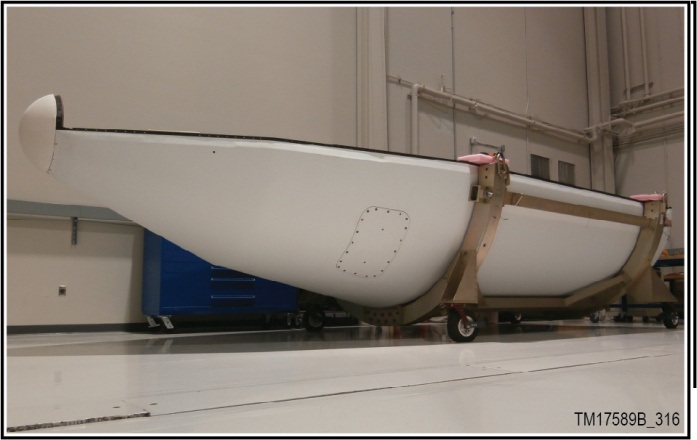
| Type | Minotaur IV Fairing |
| Diameter | 2.34m |
| Length | 6.4m (Standard) |
| Mass | 450kg |
| Separation | Ordnance, Frangible Joints,Pistons |
| Construction | Graphite/Epoxy Face Sheets |
| Aluminum Honeycomb Core | |
| Notes | Protects Payload & 5th Stage |
Minotaur V uses the standard payload fairing that is also used on the Minotaur IV/IV+ launcher. It is about 6.4 meters long and 2.34 meters in diameter weighing approximately 450 Kilograms. It consists of two composite shell halves, a low-shock frangible rail and ring separation system, and an actuator/hinge fairing jettison system. The fairing structure is a aluminum honeycomb core covered by layers of graphic epoxy composite. The fairing is outfitted with acoustic blankets, a ventilation system and RF windows if required. The fairing also provides access doors to the payloads.
The two fairing halves are joined by a frangible rail joint and the PLF is connected to the second stage using a ring-shaped frangible joint.
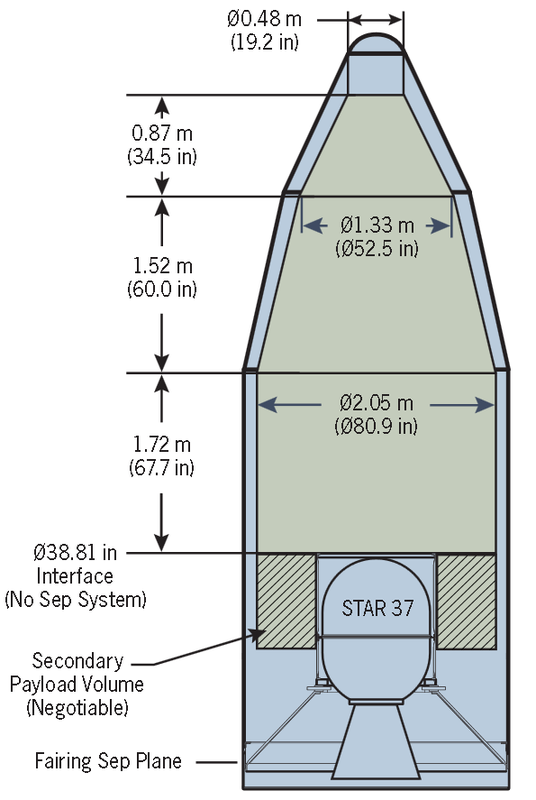
A cold gas initiation system is used to disconnect the ring and rail so that the two halves of the fairing can rotate outboard on two hinges installed on the vehicle in order to ensure the appropriate clearances during the separation event.
The payload envelope for the Minotaur V is defined by the Star 37 upper stage because it and its support structure has to fit under the fairing together with the spacecraft.
To accommodate larger payloads, Minotaur can be outfitted with a 2.79-meter diameter fairing that features a similar design, but comes at the cost of launch vehicle performance.
Payload Adapters
Minotaur can support a number of Payload Adapter Modules including off-the-shelf adapters and custom built devices. Payload Adapters interface with the launch vehicle and the payload and are the only attachment point of the payload on the Launcher. They provide equipment needed for spacecraft separation and connections for communications between the Upper Stage and the Payload.
A typical PAM consists of a Payload Adapter Fitting that is connected to the upper stage, a payload cone and a separation system. Minotaur can facilitate Orbital-built as well as Planetary Systems and RUAG Space payload attach systems.
